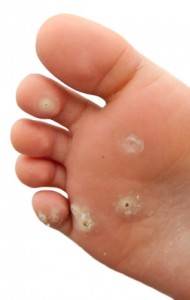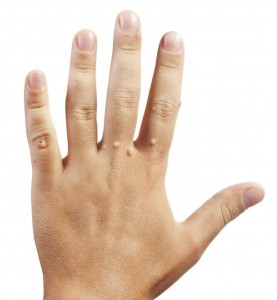Warts are bumps of dead skin tissue covering a center infected by a virus. They are caused due to human papillomavirus (HPV), a contagious virus transmitted through contact with people suffering from it. Warts are more than 100 types. While some are harmless, some might pose a serious threat to the health. Kids are more susceptible to warts than adults because of the less developed immune system. However, their warts go away while the adult’s wart sticks around.
The different types of warts include:
Warts come in different shapes and sizes. They usually look like a raised, round or oval growth on the skin. When looked closely, they appear like a little dark seed. Diferent types of warts include:
- Common warts: This wart is usually found on the hands, feet, arms and legs. They look rough, round and grayish brown in color.
- Flat warts: These warts are found on the face and neck. They are small and flat in size and often spread by shaving.
- Plantar warts: Plantar warts appear on the soles of the feet. They look like thick patches with dark speckles. Some planter warts can also grow in clusters. These are called mosaic warts. Plantar warts are extremely painful.
- Palmer warts: These warts occur on the hand. These warts usually disappear without any treatment.
- Genital wart: These warts are found on anus, vagina, and penis, between the thighs and other genital areas.
- Subungual warts: These warts appear on the toe and fingernail. They have rough bumps with an uneven surface.
- Filiform warts: These warts appear around the mouth and nose. They are neutral in color and have a thread like growth sticking out of them.

To destroy the wart, you need to destroy the underlying virus. There are a number of treatments that you can try for treating warts. Some common methods for destroying the wart include:
1. Salicylic acid:
Salicylic acid is inexpensive, has minimal side effects and comes in many forms like foam, gel, cream and liquid. Soak the wart in water for 5 minutes and then apply salicylic acid directly to the area, carefully avoiding the irritated or broken skin. Leave it for a few hours and then peel it off. File the remaining dead skin with a pumice skin. It will take at least 3 months for the warts to disappear using this method. Continue the treatment till then until the wart goes away. Apply salicylic acid twice a day for best results.
2. Duct tape:
Several studies have noted success with the duct tape method of wart removal. Cover the wart with a duct tape for 6 days. Then remove the tape and soak the wart in water. File it with a pumice stone or a nail file. Leave it uncovered and then repeat the process for six more days. If you do not notice any difference, then try the other methods mentioned here.
3. Cream:
Cream like retinoid and cantharidin can be effective at stopping the growth of warts. The chemicals present in these creams cause blistering beneath the wart, killing it. Chemical laden creams can cause some side effects.
4. Freezing cryotheraphy:
Freezing also known as cryotheraphy is a method in which liquid nitrogen is sprayed onto the wart and the surrounding area. This causes local frostbite in the area of the wart, causing the destruction of the wart. It may cause discomfort initially, but the irritation will subside after a few hours. It will take a few treatments to remove it completely. It usually takes three to four sittings to get rid of the wart. Apply salicylic acid after the skin is healed to encourage more skin peel off. There are several over- the- counter freezing kits available for treating warts.
Other methods include:
If the warts have begun spreading then you need to take severe measure to destroy them. Some of them include:
1. Surgical removal:
Surgery is an old fashion and one of the most common ways to remove warts. The doctors apply an anesthesia and cut around the wart. This method can cause scarring.
2. Electro surgery:
In electro surgery, the doctor burns away the wart with an electrical current. The wart is then cut off afterwards.
3. Laser:
Wart can be easily eliminated using electric lasers. This treatment is ideal for warts that have not responded to other treatments. The doctor uses a strong beam of laser to burn off the wart, causing it to blister. The body’s immune system will further finish and destroy the wart, heating the skin from within. Electrical laser treatment is likely to leave scars.
Pulsed dye laser removes 95% of the wart and unlike conventional laser treatments; it does not leave any scar behind. The wart’s red blood cells absorb the laser, cutting off the blood supply.
4. Needling:
This process involves jabbing the wart with sterile needles numerous times and then injecting with cortisone. Ice the wart and then poke a sterilized needle into the wart, penetrating every layer of skin. This will introduce a virus into the blood stream and will help the body to fight against the wart. This method is very effective for people who are suffering from several warts.
5. Burn if off:
Light a match and then blow it off. Touch the thwart with the head of the hot matchstick. This will cause the blistering, initiating a healing response. Peel the dead skin off and cover it with a band-aid.
Home remedies:
1. Tablets:
Crush Vitamin C tablet and mix it with water to make a smooth paste. Apply it on the wart and cover it with a bandage. Remove the band-aid at night to let it breathe. Similarly, you can also use crushed vitamin E capsule mixed with vitamin E oil to treat warts. Crush a few aspirins and mix it with water. Apply this mixture on the wart and cover it with a band-aid. Aspirin contains salicylic acid, which may help to treat warts.
2. Bleach:
Take some bleach on a cotton swab and hold it against the wart for 15 minutes. This will sting for a while, but will be fine after some time. Wash the area well after applying the bleach.
3. Tea tree oil:
Dab a few drops of tea tree oil and cover the area with a band-aid. Do this for three weeks daily for optimum results.
4. Castor oil:
Castor oil is very effective for treating flat wart on the face and the back of the hands. The acid present in castor oil irritates the wart, scraping them off. You can also mix baking powder to castor oil to form a smooth paste.
5. Basil:
Basil has a multitude of anti-viral components that can help to treat warts. It speeds up the process of the wart healing. Crush a handful of fresh basil leaves until they are juicy and apply it to the wart. The virus killing compounds in the basil kill the HMV, treating viruses.
6. Banana peel:
Rub the inside of the banana peel on the wart. Cut a section of banana peel and apply it on the wart using a duct tape. Leave it for a day and repeat until it is fully removed. Alternatively, scrape the white mush off inside the banana peel and apply it to the wart. Wash your hands after applying the paste.
7. Turmeric:
Turmeric contains Curcumin, a compound that is beneficial for treating wart. Combine turmeric with papaya and vitamin E oil. Apply it on the wart and leave it for a few hours. This technique is efficient for treating flat wart on the face.
8. Apple cider vinegar:
The high acid content in apple cider vinegar attacks the flesh that makes up the wart, killing the virus that underlies it. Take a cotton ball, soak it in vinegar and allow it to saturate. Place it over the wart and secure with a Band-Aid. Use it regularly for a few weeks until the wart starts to peel. Gently scrape off the dead skin to reveal the healthy flesh beneath. Let the area heal once it is done.
9. Water and sea salt:
Soak the water in salt water in warm water for 15 minutes to moisten the skin. Scrape the dead skin layer using a nail file until it reaches the level of the skin. The other method includes moistening the area with water and applying a chunk of sea salt to it. Secure it with a tape to hold the salt in place.
10. Dandelion:
Apply the milky sap that oozes from the dandelion stem on the wart. Repeat this three to four times a day. Scrape it off with a nail file to remove the dead layers.
Prevention:
- Do not touch the wart as it can spread from one part of the body to another. If you have touched the wart, then wash and sanitize the hands immediately. Warts can also spread through open sores, cuts and sexual activities.
- Be careful while shaving the face. Avoid shaving the area around the wart.
- If anyone in your family or your roommate has warts, do not share your personal items like soap, towel, socks, clothes, razor and deodorant with them.
- Wear footwear in public places like around a swimming pool, gym and lockers.
- Studies indicate that more than half the warts disappear within a year. Yet, some experts recommend the immediate treatment to reduce the wart. Some of them even disappear without any treatment. It could take a couple of weeks to a year for it to vanish.



